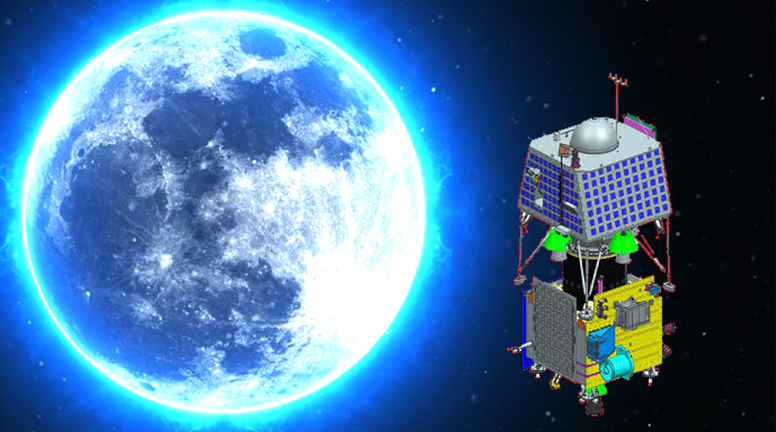Information about Chandrayaan-2:
It is India's second lunar exploration mission after Chandrayaan-1. Developed by the Indian Space Research Organization (ISRO), this mission was successfully launched from the Geostationary Satellite Launch Vehicle version 3 (GSLV Mark 3) of Sriharikota on 22 July 2019 at 02:43 PM and this mission was named as Second Chandrayaan. also known. Chandrayaan-1 mission was launched on 22 October 2008.
Brief description of Chandrayaan-2:
| Mission Name | Chandrayaan-2 |
| Director | Indian Space Research Organization (ISRO) |
| The creator | Indian Space Research Organization (ISRO) |
| Mission Type | Lunar Orbiter, Lander and Rover |
| From where projected |
Sriharikota's Geostationary Satellite Launch Vehicle Version 3 |
| launch date | 22 July 2019 |
History of Chandrayaan-2:
The representatives of the Indian Space Research Organization (ISRO) and the Russian Federal Space Agency, also known as Roskosmos, signed an agreement on 12 November 2007 for the Chandrayaan-2 project. The main responsibility was assigned to the rover, while Roscosmos was to provide the lander. The project was approved in a meeting of the Union Cabinet held on 18 September 2008 under the chairmanship of Prime Minister Manmohan Singh of the Government of India, with the design of the spacecraft completed in August 2009. The payload for Chandrayaan-2 per schedule was finalized by ISRO and the project was pushed forward to 2013 but was again rescheduled for 2016. The reason for this was that Russian scientists were unable to develop the lander on time. But later the scientists of India decided to develop the project of Chandrayaan-2 independently.
Important facts related to Chandrayaan-2:
- The primary objectives of Chandrayaan-2 are to demonstrate the ability to soft-land on the lunar surface and operate a robotic rover on the surface.
- The orbiter of Chandrayaan-2 will map the lunar surface and help in preparing its 3D map. The onboard radar will also map the surface while studying the water ice in the south polar region and the thickness of lunar regolite on the surface. The lunar topography, as per the scientific goals of the Chandrayaan-2 mission, includes minerals, elemental abundance, lunar exosphere and elements of hydrocele and water ice.
- The Chandrayaan-2 mission mission was launched with an estimated lift-off mass of 3,850 kg (8,490 lb) from the Geostationary Satellite Launch Vehicle Version 3 Satish Dhawan Space Center on Sriharikota Island.
- Chandrayaan-2 mission is the first space mission to conduct a soft landing on the south polar region of the Moon.
- The first Indian mission, which will attempt a soft landing on the lunar surface with indigenous technology and will also attempt to explore the lunar region with domestic technology.
- India is the fourth country in the world to make a soft landing on the lunar surface.
- The orbiter of the Chandrayaan-2 mission will orbit the Moon at an altitude of 100 km (62 mi). The orbiter carries five scientific instruments. Three of them are new, while two others are versions flown on Chandrayaan-1.
- The structure of the orbiter of Chandrayaan-2 mission was constructed by Hindustan Aeronautics Limited.
- The lander of the Chandrayaan-2 mission is called the Vikram lander, and named after Vikram Sarabhai, widely regarded as the father of the Indian space programme.
- Chandrayaan-2's Vikram lander will separate from the orbiter and land in a low lunar orbit. It will conduct a comprehensive check of all its on-board systems before attempting a soft landing, deploying the rover and performing scientific activities for about 14 days.
- The rover located in Chandrayaan-2 is also called Pragyan and has a mass of about 27 kg and works on solar energy and moves 500 meters on the lunar surface at the rate of 1 cm per second on 6 wheels. will carry out on-site chemical analysis, transfer the data to the lander and the lander will send the data to the Earth station.
- ISRO selected eight scientific instruments for the orbiter, four for the lander and two for the rover.
Read also:
- Indian Space Research Organisation (ISRO): History, Programs and Centers list 🔗
- ISRO Chairman List (1963 to 2023) 🔗
- Indian Space Research History, Indian Satellite List & Types of Satellites 🔗

